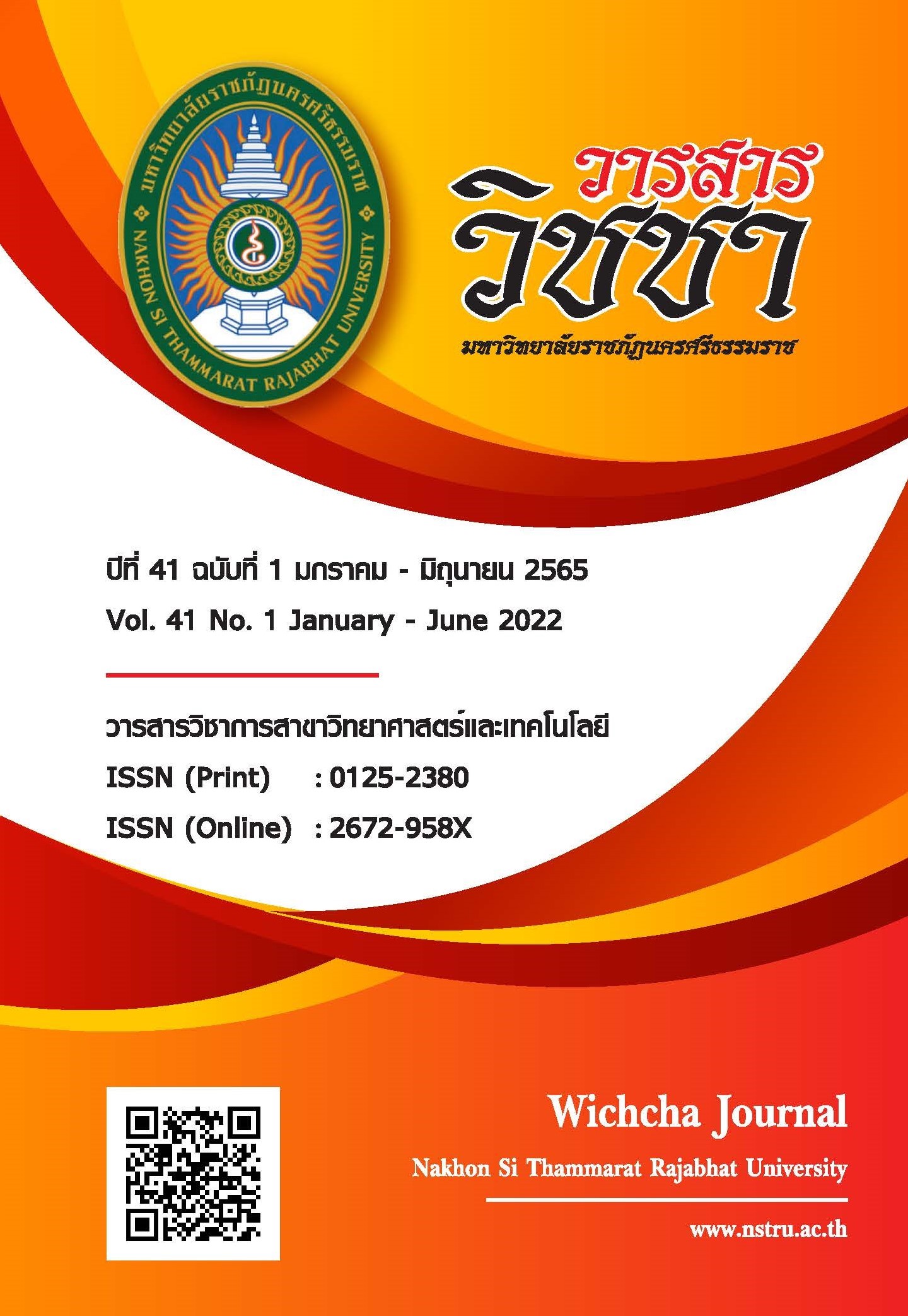ประสิทธิภาพของพืชสมุนไพรในการเป็นสารล่อเพื่อควบคุมมอดยาสูบ
Main Article Content
บทคัดย่อ
มอดยาสูบเป็นแมลงศัตรูในโรงเก็บที่สำคัญทางเศรษฐกิจของผลิตภัณฑ์ใบยาสูบ เครื่องเทศ ผลิตภัณฑ์ที่มาจากพืช และตัวอย่างสัตว์ในพิพิธภัณฑ์ การควบคุมมอดยาสูบมักใช้กับดักที่มีสารล่อ
ในการตรวจสอบจำนวนประชากรในโรงเก็บเพื่อหาวิธีการควบคุมที่เหมาะสมและปลอดภัยต่อผู้ใช้และผู้บริโภค งานวิจัยนี้มีวัตถุประสงค์เพื่อศึกษาประสิทธิภาพของพืชสมุนไพรที่มีคุณสมบัติดึงดูดมอดยาสูบและเปรียบเทียบองค์ประกอบทางเคมีของพืชสมุนไพรที่มีคุณสมบัติดึงดูดมอดยาสูบ พืชสมุนไพรที่เป็นพืชอาหารของมอดยาสูบจำนวน 15 ชนิด ได้แก่ เมล็ดพริกไทยดำ ดอกพิกุล รากโสมไทย ดอกปีบ ใบลูกใต้ใบ ฝักคูน ต้นหญ้าดอกขาว ผลมะขามป้อม ใบหม่อน ฝักกัลปพฤกษ์ ดอกกระเจี๊ยบแดง ใบชุมเห็ดเทศ ใบหญ้าหวาน ใบยาสูบ และเหง้าขมิ้นชัน ถูกนำมาทดสอบด้วยอุปกรณ์ทดสอบแบบสี่ตัวเลือก (4-choice olfactometer) ผลการทดสอบพบว่า พืชสมุนไพรที่มีคุณสมบัติดึงดูดมอดยาสูบได้ดีที่สุดคือ ใบยาสูบ รองลงมาคือ ฝักกัลปพฤกษ์ เมื่อวิเคราะห์องค์ประกอบทางเคมีของสารระเหยจากพืชสมุนไพรที่มีคุณสมบัติดึงดูดมอดยาสูบทั้งสองชนิดด้วยเครื่องแก๊สโครมาโทกราฟี-เฟลมไอออไน-เซชัน (GC-FID) พบ ß-caryophyllene และ phenylpropyl n-valerate เป็นองค์ประกอบหลักในสารสกัดจากใบยาสูบ และจากฝักกัลปพฤกษ์ ตามลำดับ องค์ประกอบทางเคมีส่วนใหญ่ที่พบในสารสกัดของพืชสมุนไพรทั้งสองชนิดเป็นองค์ประกอบทางเคมีในกลุ่มเอสเทอร์ โดยมีสารประกอบ 3 ชนิด คือ (Z)-2-hexenal isoeugenol และ phenylpropyl n-valerate เป็นองค์ประกอบร่วมที่พบในพืชสมุนไพรทั้งสองชนิด ซึ่งสามารถนำไปศึกษาเพิ่มเติมเพื่อพัฒนาเป็นสารล่อมอดยาสูบในโรงเก็บได้
Article Details

This work is licensed under a Creative Commons Attribution-NonCommercial-NoDerivatives 4.0 International License.
เนื้อหาและข้อมูลในบทความที่ลงตีพิมพ์ในวารสารวิชชา มหาวิทยาลัยราชภัฏนครศรีธรรมราช ถือเป็นข้อคิดเห็นและความรับผิดชอบของผู้เขียนบทความโดยตรง ซึ่งกองบรรณาธิการวารสารไม่จำเป็นต้องเห็นด้วยหรือร่วมรับผิดชอบใด ๆ
บทความ ข้อมูล เนื้อหา รูปภาพ ฯลฯ ที่ได้รับการตีพิมพ์ในวารสารวิชชา มหาวิทยาลัยราชภัฏนครศรีธรรมราช ถือเป็นลิขสิทธ์ของวารสารวิชชา มหาวิทยาลัยราชภัฏนครศรีธรรมราช หากบุคคลหรือหน่วยงานใดต้องการนำข้อมูลทั้งหมดหรือส่วนหนึ่งส่วนใดไปเผยแพร่ต่อหรือเพื่อการกระทำการใด ๆ จะต้องได้รับอนุญาตเป็นลายลักษณ์อักษรจากวารสารวิชชา มหาวิทยาลัยราชภัฏนครศรีธรรมราชก่อนเท่านั้น
The content and information in the article published in Wichcha journal Nakhon Si Thammarat Rajabhat University, It is the opinion and responsibility of the author of the article. The editorial journals do not need to agree. Or share any responsibility.
References
ปรมินทร์ กันทะยอม. (2559). การกำจัดแมลงในใบยาสูบด้วยความถี่วิทยุผ่านแผ่นเพลทขนาดใหญ่. วิทยานิพนธ์วิศวกรรมศาสตรมหาบัณฑิต. มหาวิทยาลัยเทคโนโลยีสุรนารี, นครราชสีมา.
ภาวินี หนูชนะภัย รังสิมา เก่งการพานิช และจารุวรรณ์ รัตนสกุลธรรม. (2560). ระดับอุณหภูมิความ ร้อนในการควบคุมแมลงศัตรูสมุนไพรอบแห้ง. วารสารวิชาการเกษตร, 35(2), 197-208.
ภูษณิศา คำตะนิตย์. (2553). การควบคุมมอดยาสูบโดยใช้โอโซน. วิทยานิพนธ์วิทยาศาสตรมหาบัณฑิต. มหาวิทยาลัยเชียงใหม่, เชียงใหม่.
สายใจ แก้วอ่อน. (2561). ฤทธิ์ต้านแบคทีเรียของสารสกัดหยาบดาหลา (Etlingera elatior (Jack) R.M. Smith). วารสารวิชชา มหาวิทยาลัยราชภัฏนครศรีธรรมราช, 37(2), 24-35.
สุทธิสันต์ พิมพะสาลี และวิโรจน์ แก้วเรือง. (2550). มอดยาสูบแมลงศัตรูหมายเลขหนึ่งของชาใบหม่อน. กสิกร, 80(3), 104-106.
อนุตร บูรณพานิชพันธุ์ และเยาวลักษณ์ จันทร์บาง. (2557). การเข้าทำลายของมอดเจาะผลกาแฟและประสิทธิภาพของสารล่อเพื่อการควบคุม. วารสารเกษตร, 30(3), 223-231.
Arctander, S. (2019). Perfume and flavor chemicals (aroma chemicals) Vol. 1. United States: New Jersey LuLu.com.
Batlle, I. and Tous, J. (1997). Carob tree. Ceratonia siliqua L. In Heller, J., Engels, J.M. M. and Hammer, K. (Eds.). Promoting the conservation and use of underutilized and neglected crops, pp. 17. Rome: Institute of plant genetics and crop plant research, Gatersleben/International plant genetic resources institute.
Fujimori, T., Kasuga, R., Matsushita, H., Kaneko, H. and Noguchi, M. (1976). Neutral aroma constituents in Burley tobacco. Agricultural and Biological Chemistry, 40(2), 303-315.
Guarino, S., Basile, S., Arif, M.A., Manachini, B. and Peri, E. (2021). Odorants of Capsicum spp. dried fruits as candidate attractants for Lasioderma serricorne F. (Coleoptera: Anobiidae). Insects, 12(1), doi: https://doi.org/10.3390/insects12010061.
Hagstrum, D.W. and Subramanyam, B. (2006). Chapter 2-Techniques. In Hagstrum, D.W. and Subramanyam, B. (Eds.). American associate of cereal chemists international, fundamentals of stored-product entomology, pp. 23-37. Washington, DC: AACC International Press.
Hill, D.S. (2012). The economic importance of insects. Dordrecht: Springer.
Hori, M., Miwa, M. and Iizawa, H. (2011). Host suitability of various stored food products for the cigarette beetle, Lasioderma serricorne (Coleoptera: Anobiidae). Applied Entomology and Zoology, 46(4), 463-469.
Johnson, D.T., Lewis, B.A., Bryant, R.J., Liyanage, R., Lay, J.O. and Pszczolkowski, M.A. (2009). Attractants for the green June beetle (Coleoptera: Scarabaeidae). Journal of Economic Entomology, 102(6), 2224-2232.
Kartika, T., Shimizu, N. and Yoshimura, T. (2015). Identification of esters as novel aggregation pheromone components produced by the male powder-post beetle, Lyctus africanus Lesne (Coleoptera: Lyctinae). PLoS ONE, 10(11), doi: https://doi.org/10.1371/journal.pone.0141799.
Kohno, M., Chuman, T., Kato, K. and Noguchi, M. (1983). The olfactory response of the cigarette beetle, Lasioderma serricorne Fabricius, to various host foods and cured tobacco extracts. Applied Entomology and Zoology, 18, 401-406.
Leffingwell, J.C. (2001). Chemical constituents of tobacco leaf and differences among tobacco types. Chemistry Preprint Archive, 2, 173-232.
Lin, C.C., Riabinina, O. and Potter, C.J. (2016). Olfactory behaviors assayed by computer tracking of Drosophila in a four-quadrant olfactometer. Journal of Visualized Experiments, 20(114), doi: https://doi.org/10.3791/54346.
Pandey, K.S., Rao, K.M. and Vaidyanathaswamy, R. (1994). Tetrahydropyran esters as new attractants for cockroaches. Bioscience Biotechnology and Biochemistry, 58(4), 647-651.
Phoonan, W., Deowanish, S. and Chavasiri, W. (2014). Food attractant from mulberry leaf tea and its main volatile compounds for the biocontrol of Lasioderma serricone F. (Coleoptera: Anobiidae). Journal of Stored Products Research, 59, 299-305.
Rees, D. (2004). Insects of Stored Products. Melbourne: CSIRO Publishing.
Ruengdech, A., Siripatrawan, U., Limbo, S., Benedetti, S. and Buratti, S. (2019). Effect of packaging on volatile profiles of mulberry tea. Italian Journal of Food Science, 7(special), 37-43.
Saeed, M., Khan, S.M. and Shahid, M. (2008). Food preferences of Lasioderma serricorne (F.) (Coleoptera: Anobiidae) on four types of tobacco. Sarhad Journal of Agriculture, 24(2), 279-284.
Suwanlaong, K. and Phanthumchinda, K. (2008). Neurological manifestation of methyl bromide intoxication. Journal of the Medical Association of Thailand, 91(3), 421-426.
Toth, M., Landolt, P., Szarukan, I., Szollath, I., Vitányi, I., Pénzes, I,. Katalin, H., Katali, J.J. and Koczor, S. (2012). Female-targeted attractant containing pear ester for Synanthedon myopaeformis. Entomologia Experimentalis et Applicata, 142(1), 27-35.
UCDAVIS. (2020). Diagnostic key classes of off-character compounds esters. California: Department of Viticulture & Enology.
van Emden, H.F., Vamvatsikos, P. and Hardie, J. (2018). Cultivar-specific plant odour preferences of a generalist aphid parasitoid Aphidius colemani and a possible mechanism for maternal priming of resistance to toxic plant chemistry. Physiological Entomology, 44(1), doi: https://doi.org/10.1111/phen.12270.
Yokoi, M. and Shimada, M. (2017). Extraction of volatile flavor compounds from tobacco leaf through a low-density polyethylene membrane. Journal of Chromatographic Science, 55(3), 373-377.

